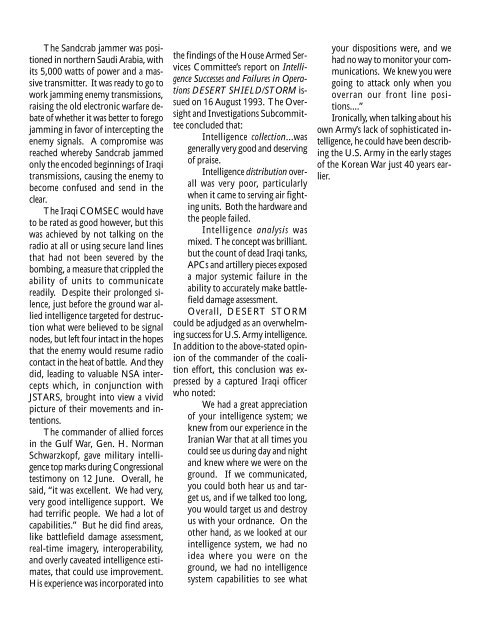Brief History of Army MI - Fort Huachuca - U.S. Army
Brief History of Army MI - Fort Huachuca - U.S. Army
Brief History of Army MI - Fort Huachuca - U.S. Army
Create successful ePaper yourself
Turn your PDF publications into a flip-book with our unique Google optimized e-Paper software.
The Sandcrab jammer was positionedin northern Saudi Arabia, withits 5,000 watts <strong>of</strong> power and a massivetransmitter. It was ready to go towork jamming enemy transmissions,raising the old electronic warfare debate<strong>of</strong> whether it was better to foregojamming in favor <strong>of</strong> intercepting theenemy signals. A compromise wasreached whereby Sandcrab jammedonly the encoded beginnings <strong>of</strong> Iraqitransmissions, causing the enemy tobecome confused and send in theclear.The Iraqi COMSEC would haveto be rated as good however, but thiswas achieved by not talking on theradio at all or using secure land linesthat had not been severed by thebombing, a measure that crippled theability <strong>of</strong> units to communicatereadily. Despite their prolonged silence,just before the ground war alliedintelligence targeted for destructionwhat were believed to be signalnodes, but left four intact in the hopesthat the enemy would resume radiocontact in the heat <strong>of</strong> battle. And theydid, leading to valuable NSA interceptswhich, in conjunction withJSTARS, brought into view a vividpicture <strong>of</strong> their movements and intentions.The commander <strong>of</strong> allied forcesin the Gulf War, Gen. H. NormanSchwarzkopf, gave military intelligencetop marks during Congressionaltestimony on 12 June. Overall, hesaid, “it was excellent. We had very,very good intelligence support. Wehad terrific people. We had a lot <strong>of</strong>capabilities.” But he did find areas,like battlefield damage assessment,real-time imagery, interoperability,and overly caveated intelligence estimates,that could use improvement.His experience was incorporated intothe findings <strong>of</strong> the House Armed ServicesCommittee’s report on IntelligenceSuccesses and Failures in OperationsDESERT SHIELD/STORM issuedon 16 August 1993. The Oversightand Investigations Subcommitteeconcluded that:Intelligence collection...wasgenerally very good and deserving<strong>of</strong> praise.Intelligence distribution overallwas very poor, particularlywhen it came to serving air fightingunits. Both the hardware andthe people failed.Intelligence analysis wasmixed. The concept was brilliant.but the count <strong>of</strong> dead Iraqi tanks,APCs and artillery pieces exposeda major systemic failure in theability to accurately make battlefielddamage assessment.Overall, DESERT STORMcould be adjudged as an overwhelmingsuccess for U.S. <strong>Army</strong> intelligence.In addition to the above-stated opinion<strong>of</strong> the commander <strong>of</strong> the coalitioneffort, this conclusion was expressedby a captured Iraqi <strong>of</strong>ficerwho noted:We had a great appreciation<strong>of</strong> your intelligence system; weknew from our experience in theIranian War that at all times youcould see us during day and nightand knew where we were on theground. If we communicated,you could both hear us and targetus, and if we talked too long,you would target us and destroyus with your ordnance. On theother hand, as we looked at ourintelligence system, we had noidea where you were on theground, we had no intelligencesystem capabilities to see whatyour dispositions were, and wehad no way to monitor your communications.We knew you weregoing to attack only when youoverran our front line positions....”Ironically, when talking about hisown <strong>Army</strong>’s lack <strong>of</strong> sophisticated intelligence,he could have been describingthe U.S. <strong>Army</strong> in the early stages<strong>of</strong> the Korean War just 40 years earlier.
















